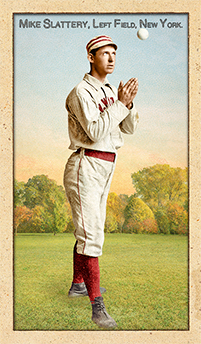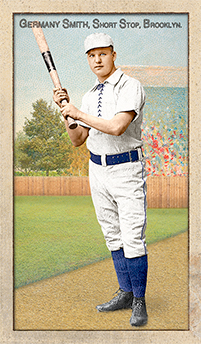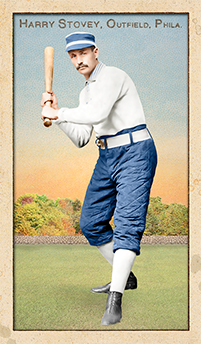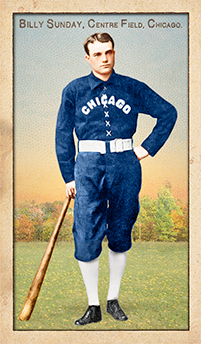- Series: Beginnings: 1880's
- City: Philadelphia
- Team: Quakers
- League: National League
Alexander Bennett Sanders (1865-1930) pitched for the Quakers, Athletics and Colonels over a 5 year career. His odd delivery left him facing 2nd base and vulnerable to the bunt. Nevertheless, Sanders went 80-70 with a 3.24 ERA. Perhaps his fielding limitations led to his yielding 2 runs despite hurling a no-hitter against the Orioles on 8/22/92—the 1st no-no where the loser scored.
- Sanders joined the ill-fated Player’s League with Philadelphia in 1890
- As a rookie, nearly achieved a 2nd no-hitter, giving up a one-out single in the 9th

- Series: Beginnings: 1880's
- City: Detroit
- Team: Wolverines
- League: National League
Frank S. Scheibeck (1865-1956) enjoyed a two-decade career that began with the Duluth Freezers and ended with his hometown Tigers at age 41 in 1906. Frank had some distinguished moments over this long haul. With the Toledo Maumees of the AA in 1890, he was the league leader for shortstops in several defensive categories while hitting .282. His performance could careen up and down, however, leading to many assignments in the minors. Undoubtedly, Frank regaled his grandkids with the tale of his role in one of the greatest ninth-inning comebacks ever: a bases-loaded double that sparked his Cleveland Blues against the Washington Senators, overcoming a 13-5 deficit on May 31, 1901.
- Remarkably, on April 25, 1901 in their first American League game, Detroit overcame a ten-run disadvantage, also in the bottom of the ninth versus the Brewers
- Played for seven major-league teams from 1887-1906
- Played for three different professional baseball teams in Detroit across three different leagues: Detroit Wolverines, NL, 1888; Detroit Tigers, WL, 1895-96; Detroit Tigers, AL, 1906.

- Series: Beginnings: 1880's
- City: Des Moines
- Team: Prohibitionists
- League: Western Association
Luke Schildknecht was a minor league catcher in the late 1880s in the midwest. Photographed by the Old Judge crew for their 1888 series, Luke appears in three known poses in a Des Moines uniform. The Baseball Encyclopedia lists Luke on the 1888 Des Moines Prohibitionists' roster, playing 26 games with a .237 BA. They indicate the same stat line for the ’88 Sioux City Corn Huskers, which had taken over the Des Moines club mid-season. Interestingly, only three players on that team lack personal data, with Schildknecht and battery mate Frank Wells being two of them. The tandem seem to have arrived and left the team at about the same time.
Dennis Pajot’s The Rise of Milwaukee Baseball documents that the Cream City team signed both Schildknecht and Wells prior to the 1889 season. However, Schildknecht is listed as the fourth-string catcher for the squad and does not appear in the historical record for the team at any time. Despite not making the team in Milwaukee, the Old Judge editors changed Luke's team designation from Des Moines to Milwaukee and continued to use the Milwaukee designation on Luke's cards throughout the rest of the Old Judge run.
- Yep, I was confused too. Took me a few years to realize that the uniform Luke is wearing in this image is a Des Moines uniform. Reversing the trend that the Old Judge guys started 128 years ago, I changed Schildknecht's team designation on this card in September, 2017, from Milwaukee to Des Moines. Balance is restored. Six cards were previously released with the Milwaukee team designation.

- Series: Beginnings: 1880's
- City: Cincinnati
- Team: Red Stockings (AA)
- League: American Association
Gustavus Heinrich Schmelz (1850-1925) managed minor and major league teams for 15 years, was popular with his players and had modest success at both levels. He was denied a pennant as second-place was the highest any team achieved under his direction. Gus led his hometown Columbus Buckeyes in the American Association in 1884 where he witnessed two of his staff hurl no-hitters within a week. Interspersed with minor league assignments, Gus managed Cincinnati’s Red Stockings for three seasons, returned to Columbus (then the Solons), and also had three NL teams: the St Louis Maroons, Cleveland Spiders and Washington Senators. Gus managed the Atlanta franchise of the newly formed Southern League in 1885 and witnessed the tragic death of one of his players. A violent collision at first base caused a ruptured liver for Lewis Henke. Schmelz had the sad duty of conducting the funeral for his strapping first-sacker who was the runner when injured on Aug 14. The Atlanta Constitution noted Henke was “…perhaps the most popular player in the Southern League.”
- Schmelz compiled a major league record of 624 wins against 703 losses (.470)
- Series: Beginnings: 1880's
- City: Indianapolis
- Team: Hoosiers (NL)
- League: National League
Otto H. Schomberg (1864-1927) played 1B and OF for parts of three seasons in the Major Leagues, for the Alleghenys and Hoosiers. He was a fine hitter but cursed with an erratic throwing arm which led to the demise of his big league career. He shuttled between first and the OF as managers tried to find a place for this promising slugger. Schomberg was also plagued by heart problems and suffered a bout of malaria that combined to end his hopes for a baseball future.
- During his only full season in 1887, Schomberg was among the top ten batters in the NL and received the Spalding Ivory Bat award as his team’s hitting leader
- Schomberg had an entrepreneurial talent that led to a successful career in the timber industry

- Series: Beginnings: 1880's
- City: Philadelphia
- Team: Quakers
- League: National League
William Frederick Schriver (1865-1932) was a durable catcher for several mostly National League teams from 1886 through 1901. His debut for the AA’s Brooklyn Grays was his only stint outside the NL. Pop had a solid .264 lifetime batting average over a 14 year major league career. During his time with Cap Anson’s Colts, to promote a game with the Senators, battery-mate Clark Griffith made a 555’ “toss” to Schriver (off the Washington Monument). Accounts differ on Pop’s performance and Griffith later said Schriver dropped the ball. In any case, history has credited Gabby Street with the first successful accomplishment of the stunt, largely on the testimony of Griffith who by then was owner of Street’s Senators. In 800 games, Schriver made 720 hits in 2,727 at-bats.
- During 1894, the year of the D.C. feat, Pop was among the league leaders in most defensive categories
- In 1901 Schriver led the league in throwing out runners attempting to steal
- Series: Beginnings: 1880's
- City: Indianapolis
- Team: Hoosiers (NL)
- League: National League
John Emmett Seery (1861-1930) played the outfield for and with some of the game’s most colorful characters in the early era of baseball. He debuted with the Baltimore Monumentals in 1884 Seery led his Union League team in batting with a .311 BA. Played under John Montgomery Ward (Ward’s Wonders of Brooklyn) and Mike “King” Kelly (Kelly’s Killers of Cincinnati) during a tumultuous age as teams and leagues were starting and folding abruptly.
- In ’86 with the St Louis Maroons, led the league in games played with 126
- Followed the team’s owner, Henry Lucas, to Indianapolis with the Hoosiers for 3 years
- Demonstrating a good eye, consistently ranked in the top 10 in walks

- Series: Beginnings: 1880's
- City: Cincinnati
- Team: Red Stockings (AA)
- League: American Association
William I. Serad (1863-1925) pitched for two major-league teams, the Buffalo Bisons and Cincinnati Reds, from 1884-88. His entire time in pro ball included seven teams over eight years. His performance in the minors was consistently better, earning him chances where he failed to rise above mediocrity, attested by his ML 35-55, 4.13 ERA record. Billy surrendered 34 HRs and was particularly victimized by Anson’s White Stockings who jumped on 15 of his offerings. He appears to have been plagued by nerves, in evidence during his debut when he walked 3 and scored 2 on wild pitches in the first inning. As a weak hitter, the manager had nowhere else to put him until he could settle down. Unlike better-hitting pitchers, Billy had to make it solely on his mound prowess which didn’t quite measure up.
- Billy wasn’t a total failure by any means. In his rookie year he won 16 of the Bisons’ 62 victories en route to a third-place finish

- Series: Beginnings: 1880's
- City: Philadelphia
- Team: Athletics (AA)
- League: American Association
Edward William Seward (nee Sourhardt) (1867-1947) was just 20 years old when he teamed with Gus Weyhing on the mound as the Athletics’ formidable starting duo, combining for 51 of the team’s 63 wins. “Kid” Seward had begun in the minors at 16 so was something of a veteran when Philadelphia made him their ace. Ed started and finished 110 games in ’87 and ’88, winning 60. He was on fire in 1888, leading the American Association in strikeouts and shutouts while hurling a no-hitter against the Cincinnati Red Stockings on July 25. He went 35-19 with a 2.01 ERA. The phenom began to burn out the following year but still posted a strong 21-15 season. His final year with the A’s, 1890, saw the Kid fall off to 6-12. A brief look with the Cleveland Spiders the following year was his last, starting a mere three games and winning two. His mound-mate Weyhing matched his no-hitter a week after Ed’s. Nicknamed “Rubber Arm,” Weyhing indeed proved the more durable, going on to a 14-year career. Nevertheless, for a couple of seasons, these two strong-armed youngsters really lit it up in the city of brotherly love.
- Seward’s overall record was 89-72 with a 3.40 ERA and 589 strikeouts
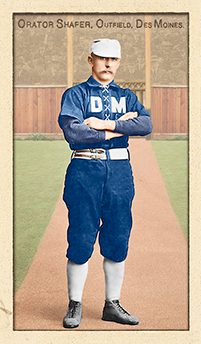
- Series: Beginnings: 1880's
- City: Des Moines
- Team: Prohibitionists
- League: Western Association
George W. Shafer (1851-1922) still ranks tenth all-time in outfield assists. The right fielder extraordinaire also continues to hold the single-season record with 50 runners cut down in 1879. Known for jawing at himself out in right if he didn’t have an umpire nearby to harangue, “Orator” was far from all talk. He had great seasons at bat and perennially ranked among the best outfielders of his day. Shafer began with the Hartford Dark Blues of the NA in 1874. Like many in the early decades of baseball, he moved around a lot. By the time he returned for a second stint with the Athletics in 1890, he had played for ten teams in 14 years. He had a great year at bat for the Indianapolis Blues in ‘78 where his .338 average was sixth in the NL. Four times he led the league in outfield assists. Orator was a key member of Cap Anson’s White Stockings, batting .304 the year he set the assist record. From 1887-89 the volatile Shafer made his living with minor league squads where he hit well and also drew a suspension for decking an umpire.
- Shafer’s final ML season was back in Philly where he was joined by younger brother (Zachary) Taylor at 2nd base
- Orator had an even 1,000 hits, good for a lifetime .282 average
- Shafer’s uniform color on this card was changed in May, 2017 from black to blue to reflect recent reliable research by Craig Brown & friends at Threads of Our Game. Two cards had been previously released featuring a black uniform.
- Series: Beginnings: 1880's
- City: Philadelphia
- Team: Athletics (AA)
- League: American Association
William A. Sharsig (1855-1902) was the esteemed GM and field manager for the Philadelphia Athletics in both their incarnations from 1886-1891. As the founder and co-owner of the original Athletics franchise, Sharsig named himself field general several times. When the Players’ League folded in 1891, he continued in baseball with the Western League’s Indianapolis club.
- His prestige in MLB prompted the NL to invite him to consult on the decision to move the mound to 60’6” in 1893
- A Philadelphian born and bred, Sharsig died there at age 46 on the eve of accepting Connie Mack’s offer to return as business manager

- Series: Beginnings: 1880's
- City: Washington, D.C.
- Team: Nationals
- League: National League
George Quintus Shoch (1859-1937) had a decade-long career in the majors, beginning in 1886 with the Washington Nationals and ending in 1897 with the Brooklyn Bridegrooms. He compiled a respectable career average of .265. George was a valuable utility man, playing outfield, short and 2nd. He demonstrated good plate discipline, striking out only 129 times in 2,924 plate appearances. George's best year was his first in Brooklyn, 1894, where he hit .317 and struck out a mere six times in 65 games. At the close of his big league tenure, Shoch showed his usual consistency, playing in 85 games for the Bridegrooms and hitting .278. Durability and consistency were hallmarks of Shoch's career.
George began pro ball in 1885 with the Eastern League's Wilmington Blue Hens, who also played in Atlantic City, and with the Hartford Babies of the Southern New England League. He remained in the game until age 46, closing out with Binghamton and Amsterdam of the New York State League. Shoch’s last games were with the tri-city team of Amsterdam/Gloversville/Johnstown where the Jags shared their talents for three seasons in three upstate NY towns.
- For one season, 1900, George was player-manager for the Philadelphia Athletics/Harrisburg Ponies of the Atlantic League
- Henry Chadwick wrote that Shoch was “the most versatile utility man the Brooklyn club has ever had”
- Shoch's uniform color on this card was changed in July, 2017 from black to blue to reflect recent reliable research by Craig Brown & friends at Threads of Our Game. One card had been previously released featuring a black uniform.
- Series: Beginnings: 1880's
- City: New York
- Team: Giants
- League: National League
Michael J. Slattery (1866-1904) was an outfielder for five teams over five seasons, including the 1888 Champion NY Giants. He debuted for the Union Association’s Boston entry (the Reds) in 1884 during that league’s only season. Slattery returned to MLB in 1888 with the NL’s Giants for two years before jumping to the NY Player’s League team in 1890. He closed his career with the Cincinnati Reds and Washington Statesmen in ’91.
- Averaged .251 at the plate over his ML tenure
- Best year was in the PL, with a .307 BA, 126 hits, 5 HRs and 18 steals
- Series: Beginnings: 1880's
- City: Brooklyn
- Team: Bridegrooms
- League: American Association
George J. Smith (1863-1927). A shortstop for 5 teams over 15 seasons, Germany once committed 7 intentional errors in a game to undermine the boasting of his pitcher that day, Phenomenal Smith. 14 errors were committed that day, the Bridegrooms lost 18-5, Germany and others were each fined $500, and Phenomenal was released. A below average hitter, Germany was an excellent defender and routinely finished in the league’s top five in many defensive categories for shortstops.
- Series: Beginnings: 1880's
- City: Baltimore
- Team: Orioles
- League: American Association
John Francis Smith (1864-1952). Despite his name, Smith never had a winning season in the major leagues, going 54-74 for 6 different teams over 8 seasons. Smith earned his nickname after striking out 16 batters in a minor league game. Before one game, Smith bragged he was so good that he did not need his teammates; they proceeded to commit 14 errors & Smith lost the game 18-5. The players were fined $500 and Smith was released.
- Discovered Christy Mathewson
- Won a minor league batting title
- Smith's uniform color on this card was changed in March, 2017 from black to blue & red to reflect recent reliable research by Craig Brown & friends at Threads of Our Game. Nine cards had been previously released featuring a black uniform.
- Series: Beginnings: 1880's
- City: Boston
- Team: Beaneaters
- League: National League
- Hall: Canadian Baseball Hall of Fame
Charles Marv Smith (1856-1927). From Nova Scotia, Canada, Smith was an infielder for 10 different teams over 12 professional seasons. On April 17, 1890, Smith walked his first 5 times up at bat and was hit by a pitch the 6th time, becoming the 1st player in Major League history to come to bat 6 times in a game and not record an official At Bat.
- Elected to Canadian Baseball Hall of Fame: 2005
- Series: Beginnings: 1880's
- City: Boston
- Team: Beaneaters
- League: National League
William Jefferson Sowders (1864-1951) pitched for the Boston Beaneaters in 1888 and ’89, moved that year to the Pittsburgh Alleghenys and left MLB after the 1890 season. He compiled a 29-30 record, striking out 205 with a 3.34 ERA. Nicknamed “Little Bill,” this 6’ right-hander was a head taller than most of his peers. Bill was the middle of three Sowders brothers to play in the major leagues. Elder brother Len pitched for the Baltimore Orioles in ’86 and John played for the Hoosiers, the KC Cowboys and Ward’s Wonders of Brooklyn over three seasons.
- Played two minor league seasons (’87 & 91) in the Northwestern League for St. Paul and Joliet of the Illinois-Iowa League

- Series: Beginnings: 1880's
- City: Chicago
- Team: White Stockings
- League: National League
Charles Wellington Sprague (1864-1912) pitched for nine teams from 1887 through 1891, three of which were in the major leagues: the National League’s Chicago White Stockings and Cleveland Spiders, and the Toledo Maumees of the American Association. His other experience was primarily in the Western Association with Jamestown of the New York-Pennsylvania League being his final stop. With the big clubs, Sprague had a respectable 10-7 record during three seasons with a 4.51 ERA. The lefty played a little outfield when not on the mound. For Toledo, Charlie was the fourth starter with Egyptian Healy being the ace. The team finished fourth in 1890, the year so many stars bolted to their start-up “Players’ National League of Professional Base Ball Clubs” (aka the Players’ League or “Brotherhood.”)
- The Goodwin guide editors note that Charlie’s Old Judge images are unusual in depicting him in two different team uniforms in the same season: Chicago’s White Stockings and Maroons in 1888
- Series: Beginnings: 1880's
- City: Philadelphia
- Team: Athletics (AA)
- League: American Association
Harry Duffield Stovey (nee Stowe) (1856-1937) was a prolific slugger and base stealer. He was the 1st in MLB to get to 100 HRs, leading the league 5 times. Stovey began his career with the Worcester Ruby Legs in 1880 and retired as a player with the Bridegrooms in ’93. Considered the premier base thief of his era, Stovey was said to have innovated the feet-first slide.
- Harry didn’t want his mother reading of him in the press as she objected to his baseball ambitions, hence the name Stovey

- Series: Beginnings: 1880's
- City: Louisville
- Team: Colonels
- League: American Association
Chilton Scott Stratton (1869-1939) pitched for four teams over eight years, from 1888-1895. He played primarily for the Louisville Colonels, a stint interrupted in 1891 by a partial season with the Pirates where he lost his only two games. Scott’s stand-out year was 1890 with the Colonels, winning 34 games and leading the league in win-loss % and ERA with 2.36. He set a major league record that still stands starting 25 consecutive games in which his team won. His team won the AA pennant that year as well. Stratton had one more 20-win season in Louisville in ’92 going 21-19. Overall, his career record was 97-114 with an ERA of 3.87.
- Stratton’s career year in 1890 included a 34-14 record in 49 starts and one relief appearance
- He was also a good enough hitter to play OF on his off days, compiling a lifetime .274 BA
- Stratton’s uniform color on this card was changed in February, 2017 from blue to maroon to reflect recent reliable research by Craig Brown & friends at Threads of Our Game. Six cards had been previously released featuring a blue uniform

- Series: Beginnings: 1880's
- City: Omaha
- Team: Omahogs
- League: Western Association
Joseph Strauss (1858-1906) was a fixture in minor league outfields from age 25 to 39 and got a a brief turn in the majors with 3 clubs from 1884-86. He entered MLB with the KC Cowboys the year they played in the short-lived Union Association, playing in only 16 games in ’84. The following season proved even slimmer pickings for “Dutch” as he was picked up by the Louisville Colonels in the AA, but appeared in only 2 games. His 1-for-6 performance must have showed them something, however, as Louisville brought Joe back the next year. He got into 74 games & hit .215 in nearly 300 at-bats. Joe’s lot improved a bit late that season when he was purchased by the competing, and stronger, Brooklyn Grays. Brooklyn would go on to a third-place finish. Strauss appeared in 9 games & hit .250 in his final experience in the big leagues. Undeterred by his mediocre showing at the top level, Joe continued his extensive minor-league career that included at least 15 teams, finishing up with Rock Island in the Western Association in 1898.
- Strauss made two relief appearances for the Colonels in ’86, saving one game. The scant data for bullpen achievement in that era records that Joe tied for the AA lead in saves that year with four other hurlers
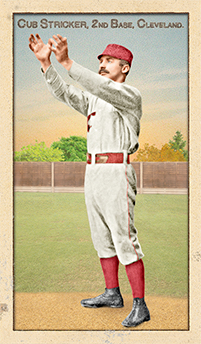
- Series: Beginnings: 1880's
- City: Cleveland
- Team: Spiders
- League: National League
John A. Stricker (nee Streaker) (1859-1937) played second base over an eleven year career in the majors. The native Philadelphian broke in with his hometown Athletics in 1882 and stayed for four seasons. He never caught fire in Philly, batting a meager .239 during his tenure there. The Athletics consigned Cub to the Southern Association’s Atlanta squad before the 1886 season. The following year Stricker was dealt to Cleveland. During his time on the shores of Lake Erie, Stricker saw the team morph from the American Association’s Blues to the NL’s Spiders and, in the 1890 uprising of the Players’ League, Cub became an Infant. He boosted his average a bit and was much more productive on offense overall. He emerged as a fairly adept base-stealer, swiping 86 in his first year with the Blues, his best on the basepaths for his career. Having never been a regular with the Athletics, Stricker was an everyday player throughout his time in Ohio and continued that pattern in 1891 when he moved to Boston with the AA’s Reds. Thereafter, Cub’s performance and plate appearances dwindled rapidly and he bounced from club to club for the remainder of his big league experience. Two episodes late in his career give evidence of a fiery temperament that made Stricker a durable competitor and even gave him a shot at managing while sometimes exposing a darker side. On at least two occasions Cub couldn’t resist the baiting of rowdy fans. His tour as manager of the Browns ended when, after a losing streak, Stricker leaped into the stands to punch a heckler. With the Senators in ‘93, in a game back home in Philadelphia, he couldn’t abide the fans’ jeers. He claimed later that the ball he loosed into the stands was meant to hit only the low fence. Unfortunately, it bounced into the stands and broke the nose of a paying customer, leading to Stricker’s arrest.
- Out of the majors following his contretemps, Cub played minor league ball for several more years, primarily in Providence for the Clamdiggers/Grays into 1896. He had a final go of it with Chester of the Pennsylvania State League in 1901 at the ripe age of 42
- Stricker received the nickname Cub due to his diminutive stature
- Stricker enjoys four known poses in the Old Judge canon, but is credited with six different cards as two cards are known in two different cropped-image variations each.
- Series: Beginnings: 1880's
- City: Chicago
- Team: White Stockings
- League: National League
Martin C. Sullivan (1862-1894) played outfield for four teams over five years from 1887-91. His first two seasons were with the Chicago White Stockings where he got into 190 games and even pitched in relief in one. He moved on to the Indianapolis Hoosiers in 1889, spent part of the next two seasons with the Beaneaters before ending his ML tenure with one game for the Cleveland Spiders.
- His lifetime BA is variously reported as .256, .273 and .288 showing the variance in data in that era
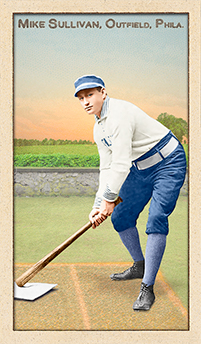
- Series: Beginnings: 1880's
- City: Philadelphia
- Team: Athletics (AA)
- League: American Association
Michael Joseph Sullivan (1860-1929) didn't play the hot corner as poorly as that ancient mariner (“he stoppeth one in three”), but let's just say that Mike made other third-basemen of his era look pretty good. Despite a respectable ability at the plate, it was defense that proved offensive to his management, leading to an abbreviated time in the major leagues. Mike lasted all of 28 games before Philadelphia sent him up to Syracuse where, four games later, his pro ball career was over. Sullivan had started out in New England playing for three teams in 1884: Meriden, Worcester and Lawrence. He stayed in the neighborhood in '85 and '87 (no record of his play in 1886). He was with Springfield and back to Meriden in '85 and Hartford in '87 before his call-up to the American Association's Athletics.
- Sullivan actually split his time between outfield and third. But it was in the infield he did his real damage. The Brooklyn Eagle eagerly recorded the game on May 13 when the hapless Sullivan played the goat, making three errors including the one that led to the Bridegrooms' victory over the Athletics
- Mike's debut that season had been at third where he made two errors subbing for Denny Lyons. He went on to make ten more miscues in his next nine games before being exiled to left field where his ability to track down the ball wasn't much improved. Despite having a slugging average that ranked behind only John Reilly and Harry Stovey among AA hitters with a minimum 100 at-bats, his bosses couldn't abide his .726 fielding percentage
- A native of Webster, Massachusetts, Mike was born on the eve of the first great national calamity, the Civil War, and died there just before the onset of the worst economic calamity, the Great Depression.
- Series: Beginnings: 1880's
- City: Chicago
- Team: White Stockings
- League: National League
William Ashley Sunday (1862-1935) was born into extreme poverty and rose to become a beloved pro player making a handsome salary. In 1891 he gave that all up to pursue Christian ministry, cutting his income by two-thirds. Al Spalding had signed Sunday to his Chicago White Stockings on the recommendation of Cap Anson in 1883. His speed was his greatest asset.
- In ’85 Chicago held an exhibition with Sunday racing the speediest AA player. Billy won easily.
- His integrity and popularity led Anson to name Sunday the team’s business manager
- Sunday was recruited for the Players’ League in 1890, but remained loyal to his employer












